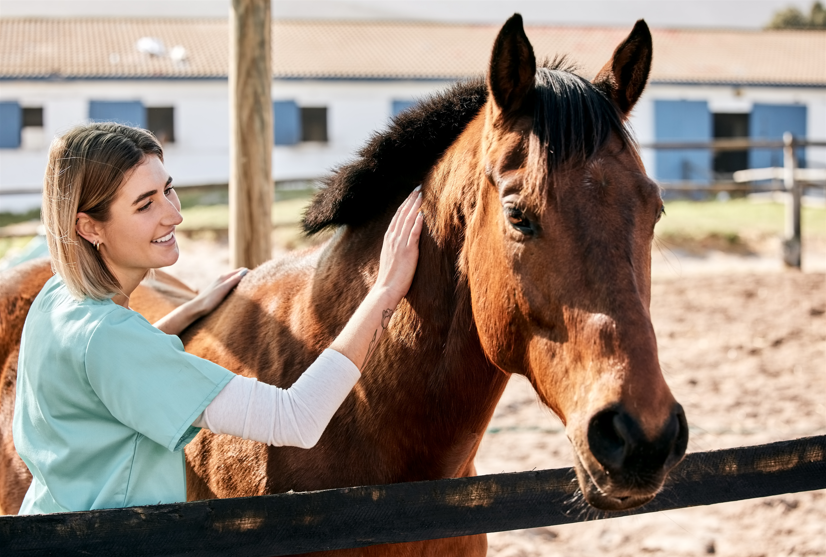Environmental Salmonella -PCR Fluxergy Test Kit
A simple and cost-effective, accurate test to identify Salmonella within the veterinary hospital environment, helping ensure biosecurity protocols are sufficient.
- Improve biosecurity and boost client confidence to mitigate risk of hospital acquired infection (HAI).
- Confirm disinfection protocol is effective and increase speed of stall turnover.
- Deliver results in < 1 hour after 16-24 hour incubation. Reference laboratory qPCR testing can take up to 3-5 days.
- Simple 10-minute test protocol following aerobic incubation allows the team to set up the test and move on with their day.

Save cost with faster stall turnover
On-site testing allows for quick answers when dealing with suspect cases:
- ICU stalls (Prior to patient admit )
- Surgical suites (Post-colic surgery)
- Horse trailers (Post-travel for stress-induced shedding)
- Routine screening of probable practice locations
- Clinics or referral hospitals
- Ambulatory practices
- Veterinary teaching hospitals
FAQs
Salmonella is a leading cause of enterocolitis in susceptible horses. Clinical cases range from asymptomatic to acute and severe diarrhea to death. Further, it is possible for disease outbreaks and population epidemics to occur depending on the organism, host and degree of exposure. It is thus recommended that PCR be used for rapid and specific pathogen detection to maintain biosecurity.
Salmonella can be isolated from a mat located in the colic surgery room. 18 of the 33 cases in this outbreak had surgery, and it is possible that some cases were infected during surgery. In other outbreaks in teaching hospitals, Salmonella has been isolated from a range of sites, including horse feeders and waterers, floor drains, stalls and stall mats, operating tables, recovery room mats and office floors.
The risk of Salmonella shedding more than doubled in patients with abdominal surgery versus non-surgical patients. Patients who underwent abdominal surgery were also eight times more likely to contract a hospital-acquired Salmonella infection.
To reduce fomite risk of Salmonella contamination, test nasogastric tubing and buckets, manure pitchforks, and ambulatory vehicle floor mats, tires and steering wheels, and tractor tires. Salmonella has been frequently isolated from reflux samples, so the risk of Salmonella environmental contamination and hospital-acquired infections is increased. Improved environmental monitoring allows for earlier detection and isolation, reducing environmental contamination.
Adult horses that had been treated with antimicrobial drugs prior to hospitalization were 3.09 times as likely to be shedding Salmonella organisms as were adult horses that had not been treated with antimicrobial drugs prior to hospitalization.
- Ward, M. P., Brady, T. H., Couëtil, L. L., Liljebjelke, K., Maurer, J. J., & Ching, C. W. (2005). Investigation and control of an outbreak of salmonellosis caused by multidrug-resistant Salmonella typhimurium in a population of hospitalized horses. Veterinary Microbiology, 107(3–4), 233–240. https://doi.org/10.1016/J.VETMIC.2005.01.019
- Ernst, N. S., Hernandez, J. A., MacKay, R. J., Brown, M. P., Gaskin, J. M., Nguyen, A. D., Giguere, S., Colahan, P. T., Troedsson, M. R., Haines, G. R., Addison, I. R., & Miller, B. J. (2004). Risk factors associated with fecal Salmonella shedding among hospitalized horses with signs of gastrointestinal tract disease. Journal of the American Veterinary Medical Association, 225(2), 275–281. https://doi.org/10.2460/JAVMA.2004.225.275
- Ekiri, A. B., MacKay, R. J., Gaskin, J. M., Freeman, D. E., House, A. M., Giguère, S., Troedsson, M. R., Schuman, C. D., Von Chamier, M. M., Henry, K. M., & Hernandez, J. A. (2009). Epidemiologic analysis of nosocomial Salmonella infections in hospitalized horses. Journal of the American Veterinary Medical Association, 234(1), 108–119. https://doi.org/10.2460/JAVMA.234.1.10
- Rothers, K. L., Hackett, E. S., Mason, G. L., & Nelson, B. B. (2020). Atypical Salmonellosis in a Horse: Implications for Hospital Safety. Case Reports in Veterinary Medicine, 2020. https://doi.org/10.1155/2020/7062408
- Dallap Schaer, B. L., Aceto, H., Caruso, M. A., & Brace, M. A. (2012). Identification of Predictors of Salmonella Shedding in Adult Horses Presented for Acute Colic. Journal of Veterinary Internal Medicine, 26(5), 1177–1185. https://doi.org/10.1111/J.1939-1676.2012.00984.X












.svg)
.svg)